CarEdge saved me over 4,500 dollars on a brand new Honda Pilot. I can't say thank you enough.
Price intelligence
Find a wide range of vehicle listings with market insights on new and used listings near you.


Help us personalize your CarEdge experience — it only takes a second.
Your answers help us personalize your CarEdge journey — we’ll follow up with tips and next steps that match your buying timeline.
We’re constantly told that electric vehicles are the future. But a closer look at recent sales data suggests that, for some models at least, the future isn’t quite here yet. Let’s switch gears and delve into fresh data to understand what all the fuss is about.
The market for electric cars, trucks and SUVs is growing, no doubt about it. Our updated analysis of EV market share has EV sales above 7 percent for the first time. However, as with any burgeoning market, there are growing pains. Some new electric models are spending months on dealer lots, while others seem to be driving off as soon as they arrive.
So, what’s causing these unexpected hold-ups in EV sales? To answer that, we need to take a closer look at a metric of market health that is too often overlooked by car buyers: days supply. “Days supply” is a term used in the automotive industry to represent the number of days it would take to sell all of a particular car model in inventory, given the current sales rate.
In 2023, the days supply of non-Tesla EV models keeps getting weirder and weirder. Why don’t we have Tesla data to share? Well, no one has that except Tesla, since they sell direct-to-consumer, along with Rivian, Polestar, Lucid and a few other low-volume automakers. Analysts have to wait until sales numbers are released for any real insight. We DO, however, have some interesting USED Tesla numbers to dig into. More on that in a bit.
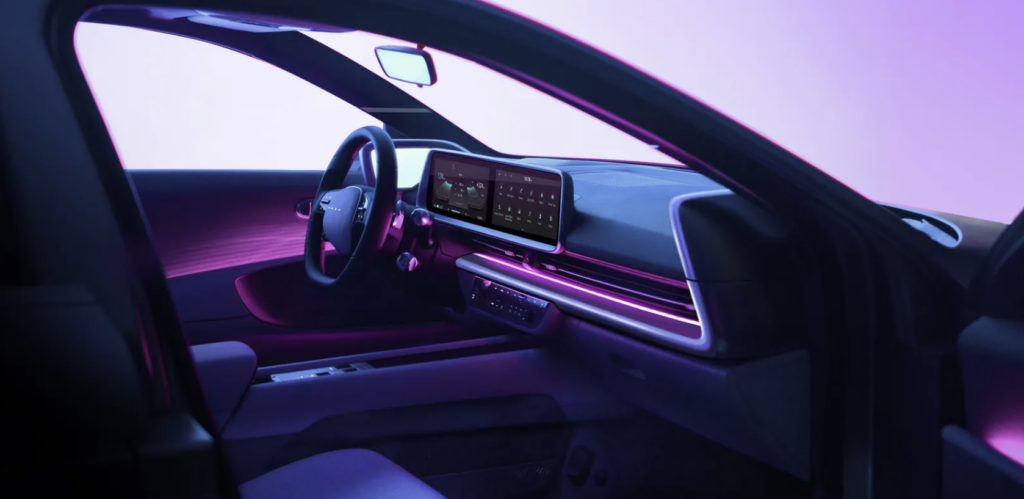
The latest from CarEdge Data reveals some surprising numbers. New EV inventory is above and beyond anything we’ve ever seen before.
The Mustang Mach-E, despite being highly anticipated and once labeled a ‘Tesla-killer’, now has a supply of 153 days. Meanwhile, other popular EVs like the Hyundai IONIQ 5 and 6, are taking 110 and 159 days, respectively, to sell. The IONIQ 5 was last year’s Car and Driver EV of the Year, only to pass that same title on to the IONIQ 6 in 2023. You’d think they’d be selling like crazy, right?
And that’s not all. Nissan’s Ariya is sitting for a whopping 219 days before finding a new home, and the Subaru Solterra isn’t far behind with 199 days.
Here’s current dealer inventory for every new electric vehicle in America, except Tesla and the other direct-to-consumer automakers.
| Make | Model | New/Used | Days Supply (7/28/23) |
|---|---|---|---|
| Ford | Mustang Mach-E | new | 210 |
| Chevrolet | Bolt EV | new | 44 |
| Chevrolet | Bolt EUV | new | 33 |
| Hyundai | IONIQ 5 | new | 116 |
| Hyundai | IONIQ 6 | new | 159 |
| Genesis | GV60 | new | 200 |
| Kia | EV6 | new | 146 |
| Volkswagen | ID.4 | new | 150 |
| Audi | Q4 e-tron | new | 153 |
| Porsche | Taycan | new | 152 |
| Mercedes | EQS | new | 194 |
| Mercedes | EQB | new | 101 |
| BMW | i4 | new | 61 |
| BMW | i7 | New | 174 |
| Volvo | C40 | new | 132 |
| Subaru | Solterra | new | 199 |
| Nissan | Ariya | new | 176 |
| Nissan | Leaf | new | 140 |
| Toyota | bZ4X | new | 190 |
| Ford | F-150 Lightning | new | 103 |
| GMC | Hummer EV | new | 90 |
Remember when GM executive Bob Lutz couldn’t stop hating on Tesla? For years, he went on and on about how the then-EV startup was doomed to fail. Making cars was just too hard and unprofitable, he said.
Three short years later, and boy was he wrong. Tesla is STILL the king of EV sales, and to rub salt on the wound, Tesla is now convincing one legacy automaker after another to adopt their once proprietary charging standard, GM included. What does all of this have to do with EV inventory numbers in 2023? Let me explain.
Tesla’s bold pricing strategy is driving a shift in the EV market. They initiated massive price cuts this year, predominantly affecting their widely circulated Model 3 and Model Y, and creating a ripple effect in the sector.
These strategic reductions, alongside stabilizing gas prices, rising interest rates, and thrifty consumers, resulted in less demand. When demand dropped, Tesla lowered prices.
Tesla’s price reductions triggered a downward trend in the new EV market. The Model Y began 2023 at $65,990 in the U.S., but price cuts and a cheaper base variant slashed the base price of the Model Y to $47,240 by early May. With access to the Supercharger network, over-the-air updates and longer range, many drivers looking to go electric simply went for the Tesla, leaving the competitors to pile up on dealer lots.
By the way, used Tesla models are still in demand. Days supply remains just slightly above average, and far below new EV inventory. Here’s a look at used Tesla inventory nationwide in July 2023:
| Make | Model | New/Used | Days Supply | Total For Sale | Total Sold (45 Days) |
|---|---|---|---|---|---|
| Tesla | Model Y | used | 65 | 1889 | 1304 |
| Tesla | Model 3 | used | 56 | 4564 | 3664 |
| Tesla | Model S | used | 91 | 2470 | 1218 |
| Tesla | Model X | used | 73 | 1382 | 850 |
Let’s take a closer look at the demand issue. Despite the buzz, not all EVs are finding eager buyers right off the bat. Let’s plug into a few potential reasons: price, charging infrastructure, vehicle range, and brand reputation.
First, despite the falling prices and high inventory, electric cars are expensive. The average EV price remains about 15% higher than that of the average conventional car. Those who really put on the miles can recoup that money through fuel and maintenance savings, but what about urban dwellers who may drive just 5,000 miles a year?
This higher upfront cost might deter many potential buyers, especially those with a limited budget or those who drive less frequently.
Secondly, the charging infrastructure for EVs is still developing and leaves much to be desired. This is especially true in rural America. Those who live in apartments, condos, or similar situations may not have any way to charge at home to begin with. And then there are variables like cold weather, towing, and high-speed driving that all impact an electric vehicle’s range, and undermine consumer confidence in EVs.
Lastly, there’s a cultural shift required to adapt to the EV lifestyle. Transitioning from gas stations to charging points, understanding charging times, and adjusting to the inability to simply work on your car in the garage are just some of the challenges for the everyday driver. In addition, for those who love the roar of an internal combustion engine or frequent long, remote road trips, an EV might not be ideal.
These are the BEST EVs for families today (price, range and more)
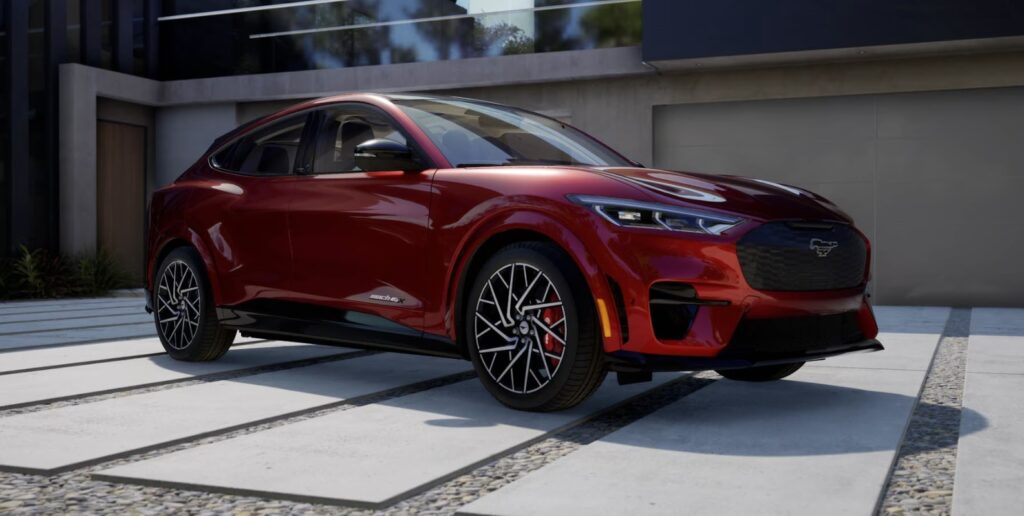
So what does this mean for you, the potential EV buyer? If you’re considering one of these slow-sellers, you might be able to secure a great deal. Some (but not all) dealers could be more than ready to sell their electric inventory, which could increase your negotiating power.
In fact, even before the most recent spike in electric vehicle inventory, we shared a few of the many examples of CarEdge community members negotiating thousands off of EV sticker prices. Yup, EVs are indeed negotiable!
Take this negotiation cheat sheet with you to the dealership!
What does it all mean for manufacturers? These trends could be a wake-up call. Legacy automakers and newcomers alike may need to adjust their strategies, rethink pricing, improve vehicle specs, or invest more in marketing and public education to attract buyers who may be on the fence about going electric.
Perhaps it’s too early to claim that these EVs are ‘struggling’. After all, every new technology takes time to become mainstream. And as more people embrace the benefits of electric driving, demand for these slow-selling models might well pick up speed.
But for now, savvy buyers could use this opportunity to drive a hard bargain on a brand-new EV.

Ever heard the phrase ‘patience is a virtue’? In the world of used car buying, it’s more than just a virtue – it’s a strategy. With recent fluctuations in used car prices, knowing when to dive into the market can be the difference between an okay deal and a fantastic bargain. But when will car prices drop? As it turns out, the answer lies in understanding the data behind the trends. We’ll unpack the latest used car market update to reveal why the smartest buyers might want to play the waiting game.
The latest numbers from Cox Automotive are making headlines. In June, wholesale used car prices dropped by -4.2%, with an overall decrease of -10.3% compared to the previous year. June’s decrease was an all-time record for the month, and is second only to the pandemic plunge in car prices during April of 2020.
Here’s where some of the headlines are missing the point: the sharpest declines are being seen at wholesale auctions. These are the auctions that the dealers themselves buy from, not where the average consumer will find their next ride. Surely wholesale price trends will be mirrored in retail prices quickly, right? Not so fast.
On the retail side, the used car price decreases have been more modest. Retail used car prices fell by just -0.5% over the last month, revealing an unsurprising mismatch between wholesale and retail trends. Let’s dig a bit deeper into that…
But why does this gap between wholesale and retail used car prices exist? Simply put, retail prices typically lag behind wholesale trends. This is due to the time it takes for changes in the wholesale market to trickle down and affect retail prices. Dealers want to squeeze every possible dollar out of their inventory, so it takes a while for market trends to finally be reflected in sticker prices (and negotiability).
Therefore, if you’re planning to buy a used car, it’s likely worth waiting 30, 60, or even 90 days. The drastic declines in wholesale auctions seen today will likely translate to better retail prices in the coming months.
Why not now? Consider the following: We track used car prices weekly here with the help of Black Book. In the graph below, you can clearly see the marginal price movement on the retail side of the market. Retail used car prices in fact remain above where they started 2023.
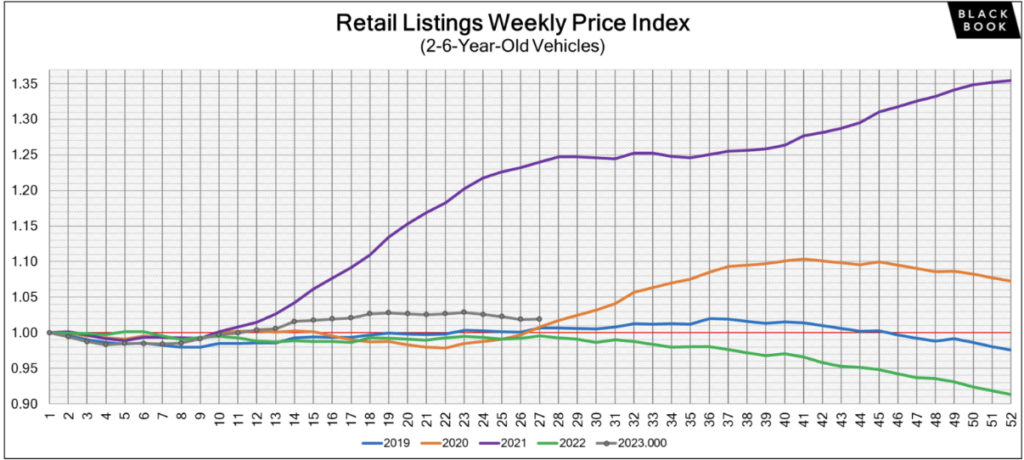
In this next graph from Black Book, we see the more noteworthy price declines on the wholesale side.
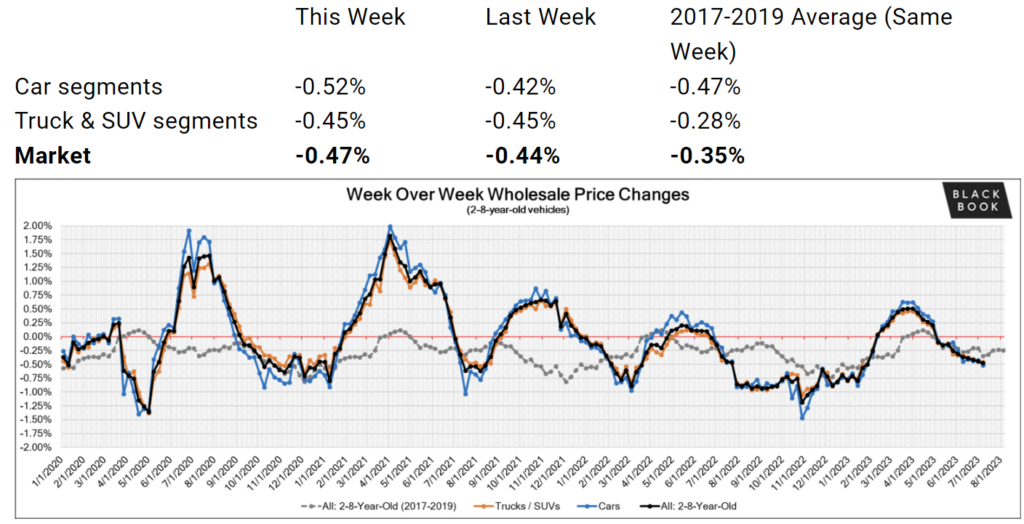
Before you head to the dealership, know this: retail car prices typically lag behind wholesale price trends by one to three months. To save the most on your used car, we recommend waiting 30, 60 or 90 days for retail prices to really come down.
Rushing out to dealer lots today could cost you, as dealers today are very likely to ‘play dumb’ and hold off on lowering prices for as long as they can.
These changes don’t just affect buyers; they also have significant implications for those looking to sell or trade in their vehicle. The most immediate impact of falling used car prices is a decrease in trade-in values. If you’re certain about selling or trading in your car, it’s wise to complete the sale as soon as possible to get the best value.
Compare offers from trusted online buyers with CarEdge today before used car values plummet…
These price trends come alongside a decrease in retail sales for June and a continued rise in used car inventory. ‘Days supply,’ a common industry metric used to compare inventory while also factoring in the daily sales rate, continues to climb for most used vehicle segments. This means that more cars are available, but they are also staying on the lot longer.
Interestingly, the major vehicle market segments saw their seasonally adjusted prices remain lower year over year in June. Compared to June 2022, pickups and vans have fared better than most, losing 6.6% and 8.5% respectively. Sports cars took the hardest hit at 14.8% year-over-year, while compact cars lost 12.6%, and midsize cars dropped by 12.2%. When compared to last month, all segments were down, with compact and midsize cars experiencing the most significant declines.
The rapid fall in used car prices has put car dealerships in a tough spot. Dealers (and their lenders) are under a significant cash crunch. You’re not the only one borrowing money for your next car. Dealers themselves have to pay interest for every day a car sits unsold on their lot, creating a time-is-money dilemma. Car dealerships typically take out loans to purchase inventory at auction, and then pay interest on that loan until the car is sold. This hidden expense is called ‘floorplanning costs’, and they’re rising for dealers in a time of interest rate hikes.
They desperately want to make the most money possible from the sale of each car on their lot. This is their path to profits. However, quickly-changing market dynamics are throwing a wrench in their plans. As used car values fall quickly, dealers are finding themselves in a precarious situation.
Using the market analysis tools available through CarEdge Data, we identified the ten mainstream used cars with the MOST inventory today. These are the used cars that you’re more likely to negotiate a better deal with today.
| Make | Model | Days Supply | Total For Sale | Sold (45 Days) |
|---|---|---|---|---|
| Jeep | Grand Cherokee WK | 155 | 947 | 275 |
| Ford | F-350 | 123 | 1188 | 436 |
| Chevrolet | Impala Limited | 119 | 658 | 248 |
| Chevrolet | Bolt EV | 114 | 1913 | 753 |
| Jeep | Grand Cherokee L | 113 | 3653 | 1451 |
| Jeep | Grand Wagoneer | 110 | 556 | 227 |
| Audi | A8 | 106 | 692 | 294 |
| Ram | 1500 | 106 | 3535 | 1501 |
| Volkswagen | ID.4 | 105 | 675 | 289 |
| Audi | e-tron | 104 | 882 | 382 |
Are there really any surprises here? Trucks can’t sell right now, and just the other day we did a deep-dive into Jeep’s unprecedented glut of inventory.
In the weeks and months ahead, we fully expect to see more models reaching over 100 days supply on the used car market. Electric vehicles and trucks are piling up on dealer lots as we speak!
Negotiating will be tougher with these models in short supply. Note that this list is full of vans and SUVs. These family haulers remain in demand, but the good news is that van and SUV prices have fallen more than the overall market average in recent months. Follow our weekly used car price updates here.
| Make | Model | Days Supply | Total For Sale | Sold (45 Days) |
|---|---|---|---|---|
| Tesla | Model 3 | 55 | 4439 | 3635 |
| Toyota | Sequoia | 55 | 833 | 685 |
| Toyota | Sienna | 55 | 5938 | 4881 |
| Honda | Fit | 54 | 1961 | 1635 |
| Subaru | Ascent | 54 | 3567 | 2946 |
| Ford | Transit | 52 | 961 | 826 |
| Lexus | RX Hybrid | 52 | 804 | 692 |
| Chrysler | Voyager | 50 | 1555 | 1408 |
| Honda | Odyssey | 49 | 6272 | 5791 |
| Porsche | 718 | 49 | 505 | 464 |
There’s more money-saving data where that came from! Try CarEdge Data today to unlock the auto market insights dealers don’t want you to see.
While the current market might seem chaotic, let’s not forget that “patience is a virtue”. As we’ve seen, smart car buyers will benefit significantly from holding off for the next 30 to 90 days. This brief period of waiting will yield better deals and greatly increased negotiability as dealers become eager to offload their inventory. It’s not about being lucky – it’s about being patient and strategic.
To navigate the changing used car market, consider getting expert help from CarEdge. Our CarEdge Data plan provides you with up-to-date, behind-the-scenes market insights that can help you seize the best opportunities. Featuring the latest Black Book vehicle valuations, CarEdge Fair Price and official recommendation for every listing, and three CarEdge Reports per month, you’ll have the tools you need to secure a great deal.
Likewise, a CarEdge Coach can guide you through the process, ensuring you’re equipped with the knowledge and confidence to make the most out of your car buying experience.
Remember, the savviest of car buyers follow the data, not the headlines. Stay patient, stay informed, and get ready to snag that excellent deal on your dream used car soon!
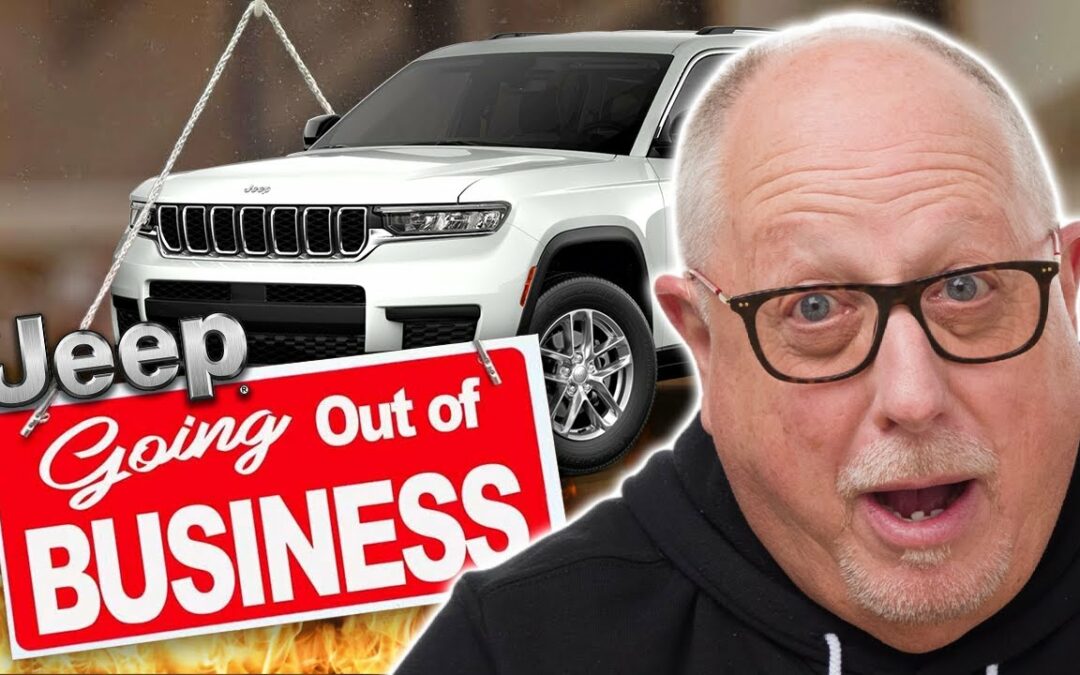
Jeep sales are slipping in 2024. Yes, the brand known for all-terrain traction is having a really hard time keeping up in today’s new car market. Inventory is piling up, 2023 models remain unsold, and yet, prices are soaring higher than ever. It seems that Jeep has plunged headlong into a sales crisis, leaving their brand new vehicles gathering dust on dealer lots.
At CarEdge, we’re all about empowering car buyers to take control of their deal. If you’re in the market for a new or used Jeep, you won’t want to miss this one. For the savvy Jeep fan, major savings could be on the horizon. Let’s dive in.
Inventory is the lifeblood of the car industry, and Jeep is no exception. An abundance of cars on the lot can indicate slow sales, creating an environment where buyers could potentially nab themselves an attractive deal. Simply put, it’s a buyer’s market when there’s too much inventory. That’s generally the case for any product, but it’s especially true for automakers as 2024 models pile on to dealer lots.

This year, however, it appears that Jeep has been having a hard time selling their cars. 2024 model-year inventory is through the roof, and last year’s cars are still in need of an owner. It’s amazing how much 2023 inventory Jeep still needs to sell, with nearly 48,000 new 2023 models on dealer lots nationwide. Shockingly, Jeep still has 2,000 new 2022 models that remain unsold.
But let’s look deeper into the data. The Market Day Supply (MDS), the measure of how long it would take to sell all current inventory at the current sales rate, can provide critical insights into the state of sales. Right now, Jeep’s MDS dominates the list of the new cars with the most inventory. This is an alarming sign that Jeeps are spending far too much time on lots before finding a home.
Here’s a quick breakdown of every Jeep model’s inventory:
| Make | Model (New 2023) | Market Day Supply | Nationwide Inventory |
|---|---|---|---|
| Jeep | Renegade | 211 | 10,765 |
| Jeep | Cherokee | 170 | 3,571 |
| Jeep | Grand Wagoneer | 313 | 3,744 |
| Jeep | Gladiator | 201 | 20,965 |
| Jeep | Wagoneer | 172 | 3,921 |
| Jeep | Grand Cherokee | 187 | 39,874 |
| Jeep | Grand Cherokee L | 175 | 20,526 |
| Jeep | Compass | 217 | 25,768 |
| Jeep | Wrangler | 96 | 1,496 |
| Jeep | Wrangler Unlimited | 170 | 27,837 |
| Jeep | Brand Total | 153 | 143,003 |
It’s clear that the Renegade, Cherokee, Compass, Gladiator and Grand Wagoneer are struggling the most with high MDS and large amounts of inventory still unsold, but they’re not outliers. All Jeep models aside from the Wrangler Unlimited have over 100 day supply right now.
In the auto industry, a market day supply of 60 to 70 days is considered ‘healthy’. Jeep’s inventory has a high fever right now, and the only remedy is to sell cars soon.
For comparison’s sake, here are the ten new car models with the highest inventory right now.
| Make | Model | Market Day Supply | Average Transaction Price | Total For Sale | Total Sold (45 Days) |
|---|---|---|---|---|---|
| Ram | Ram 2500 Pickup | 460 | $88,679 | 33,908 | 3,316 |
| Dodge | Hornet | 432 | $37,588 | 5,790 | 603 |
| Ram | Ram 3500 Pickup | 367 | $81,263 | 12,164 | 1,492 |
| Jeep | Grand Wagoneer | 336 | $104,821 | 3,487 | 467 |
| Chrysler | Pacifica Hybrid | 331 | $56,181 | 7,310 | 995 |
| Jaguar | F-Type | 292 | $100,916 | 603 | 92 |
| BMW | 5-Series | 288 | $70,658 | 1,881 | 294 |
| Dodge | Challenger | 273 | $52,012 | 20,574 | 3,386 |
| Ram | Ram 1500 Pickup | 238 | $60,765 | 60,606 | 11,454 |
| Mercedes-Benz | EQS | 212 | $123,179 | 4,837 | 1,025 |
Still not convinced it’s that bad? Here are the new cars with the lowest inventory. Note that this list is the result of both high sales volumes AND low production numbers for some automakers.
| Make | Model | Market Day Supply | Average Transaction Price | Total For Sale | Total Sold (45 Days) |
|---|---|---|---|---|---|
| Chevrolet | Colorado | 19 | $41,495 | 3,796 | 8,954 |
| Toyota | Corolla Hybrid | 23 | $26,563 | 1,020 | 2,034 |
| Toyota | Prius | 24 | $34,185 | 1,600 | 2,974 |
| Mercedes-Benz | GLC | 27 | $57,272 | 1,873 | 3,103 |
| Honda | Civic | 27 | $27,151 | 10,418 | 17,118 |
| Honda | CR-V | 27 | $35,902 | 25,208 | 42,535 |
| Toyota | Sienna | 28 | $50,963 | 5,939 | 9,556 |
| GMC | Canyon | 28 | $49,415 | 1,375 | 2,184 |
| Toyota | Corolla Cross | 31 | $31,515 | 9,251 | 13,253 |
| Kia | Carnival | 31 | $42,360 | 3,871 | 5,583 |
Despite these alarming figures, Stellantis, the parent company of Jeep, remains undeterred. In fact, it appears that they are doubling down on their strategy of ‘price high, hope for the best’. The average transaction price for a Jeep is now $53,913. For the first time ever, Jeep buyers are more likely to pay luxury prices than anything remotely resembling the sub-$40,000 prices of yesteryear.
And Stellantis is all-in on luxury pricing. The critically-acclaimed Jeep Grand Wagoneer starts with an MSRP north of $60,000, with most on the lot going for well over $75,000. A quick glance at CarEdge Car Search shows that even a humble Wrangler Unlimited is likely to cost you north of $50,000. See for yourself.
When it comes to an automaker’s #1 way to sell cars, Stellantis seems to be neglecting the Jeep brand. That would be incentives. Or in Jeep’s case, the lack thereof.
We track manufacturer incentives monthly, and it couldn’t be more clear that Jeep’s parent company is in no hurry to move inventory. Despite dominating the Top 10 list for the most inventory, Jeep is nowhere to be seen on the list of best incentives this month. You’d think there would be a correlation there. Not so!
To make matters worse, Jeep dealers have become notorious for making customers jump through hoops to get a fair price. We’ve recently seen $100,000+ Jeeps, and an abundance of bait and switch dealer pricing.
Here’s one of many examples that car buyers have shared on the CarEdge Community Forum. This Jeep dealer in Florida adds several thousand dollars in pointless fees to the already sky-high sticker price:

On top of the B.S. ‘Naples Advantage’ fee, there’s a $1,198 doc fee. That’s because Florida is one of the only states that doesn’t put a limit on doc fees, and dealers love taking advantage of that. Yup, over $1,000 to ‘file the paperwork’.
It is abundantly clear that Jeep dealer pricing is reliant on unaware, unsavvy car buyers who will pay the sticker price without hesitation. Fortunately, the car buyer in this example was a CarEdge member, and knew how to push back against B.S. dealer ripoffs.
This reliance on consumers’ lack of awareness doesn’t just reflect poorly on the dealers – it’s a black mark on Jeep itself. Jeep, it’s time to take better care of your customers!
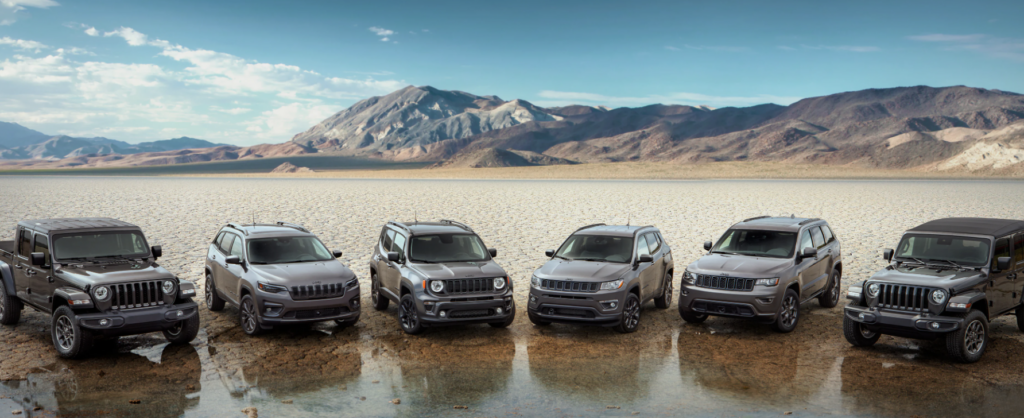
Unlike car buyers in decades past, you now have a powerful tool at your disposal: information. Knowledge is power in negotiation, and these high inventory numbers reveal a potentially golden opportunity. For the prepared and knowledgeable buyer, Jeeps will become increasingly negotiable in 2024. But as we’ve seen, don’t expect dealers to be giving out great deals. You’ll almost certainly have to work for it.
Our CarEdge Car Coaches understand this and are ready to help you save thousands on your next vehicle. They know that the first step in getting a good deal is understanding the market conditions. Our team of experts is ready to help you identify savings opportunities, no matter what new or used car you’re in the market for.
Looking for DIY car buying help? Our CarEdge Data plan is just for you. Using behind-the-scenes market insights and the data goldmine found in every CarEdge Report, you’ll be equipped with insider tools to save you big-time.
In summary, be savvy, do your research, and don’t be afraid to walk away if the deal isn’t right. It’s a great time to be a Jeep buyer—if you know what you’re doing. Dealers might be playing hardball, but you can play the game too. And now, you have the data to back you up.

Looking to save with Fourth of July car sales? Our team at CarEdge has curated a list of standout offers that could save you 10% or more on your next vehicle. These deals are currently unfolding in a changing car market, with some brands eager to sell, and others not so much.
Who has the best car deals right now? Is now the best time to buy? Exactly how much should you negotiate? We’ll answer these questions and more. Let’s dive in!
When it comes to manufacturer incentives, automakers are all over the place with their pricing and deals right now. It pays to know where the best deals are. These five automakers are in a hurry to sell cars, and you, the car buyer, can benefit.

Browse Ford listings in your area
Ford’s dealer lots are filling up, and you know what that means: bring on the incentives! For the Ford Edge, they are offering 0% APR for 72 months, and for the Mustang, buyers can qualify for 0% APR for 60 months. The Bronco Sport, Expedition, Explorer, and F-150 come with a 0.9% APR for 60 months.
Additionally, the F-150 also qualifies for up to $2,000 in cash rebates. Ford is having a really hard time selling electric vehicles like the Mustang Mach-E since Tesla undercut pricing, so don’t hesitate to negotiate EV prices this summer. More on that here.
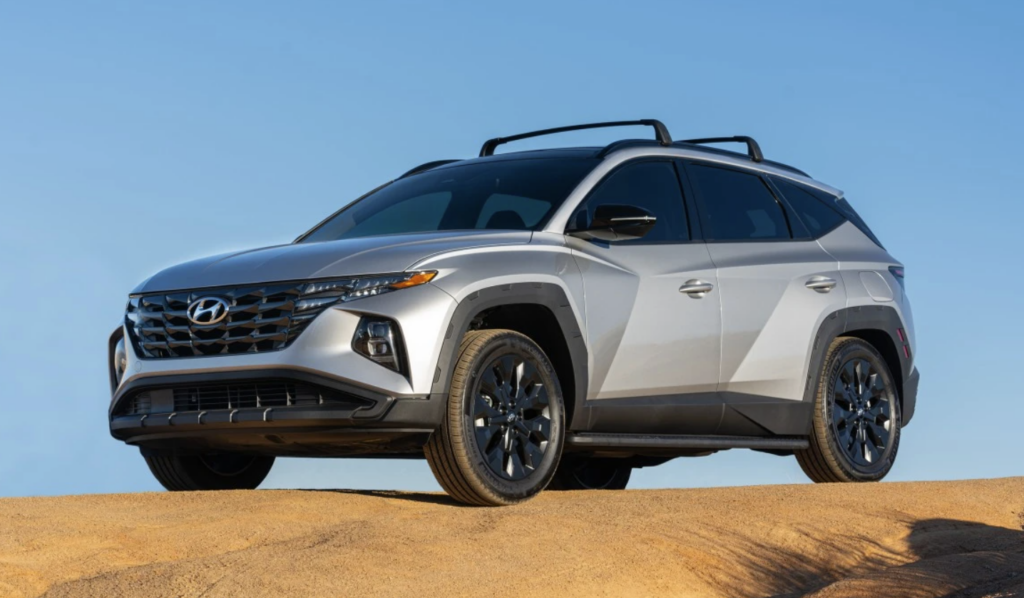
Browse Hyundai listings in your area
Hyundai is celebrating this Fourth of July with a range of deals across several of their models. The Santa Fe and Tucson models come with a 0.99% APR for 48 months. The all-new Ioniq 5 is available with a 1.49% APR for 60 months. Hyundai’s electric sales have slipped since the brand lost eligibility for the federal tax credit here in the States. Lastly, the Kona, Kona Electric, and Sonata all come with a 1.99% APR for 48 months.
If you’re on the hunt for Car and Driver’s 2023 EV of the Year, the all-new Hyundai IONIQ 6, you can secure 2.75% APR for 60 months (but again, there’s no federal tax credit). Don’t forget to check EV incentives in your state.
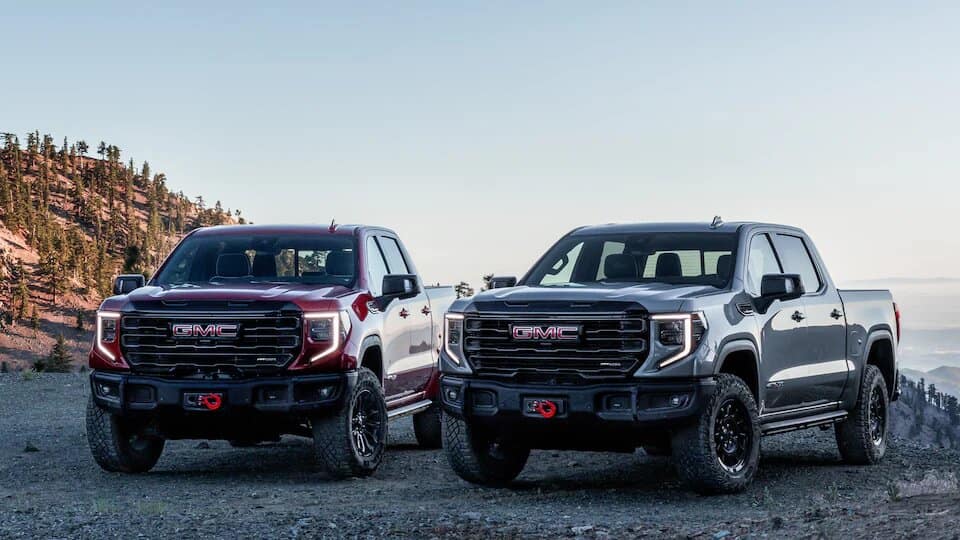
Browse GMC listings in your area
2023 GMC Sierra 1500: Buyers can enjoy a 0.9% APR plus $1,250 cash back. Plus, with high lot inventory (over a 100 day supply in most areas), dealers are often willing to sell the Sierra 1500 well below the sticker price.
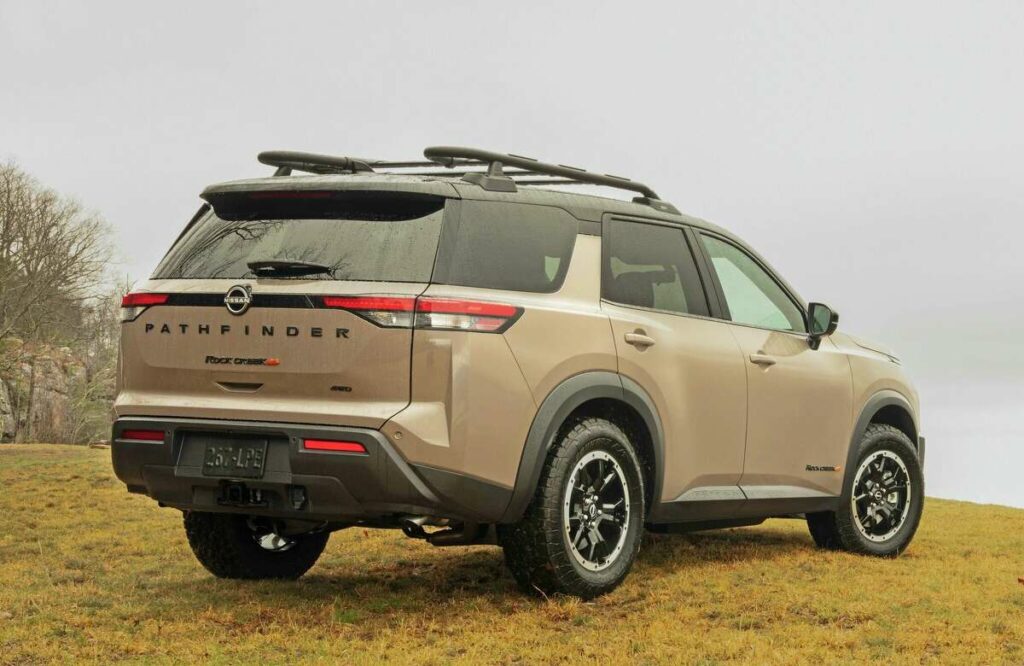
Browse Nissan listings in your area
This brand has several great financing deals across their model lineup. Nissan’s Fourth of July offers include 0% for 60 months for the Titan, 0% for 36 months for the Murano and Rogue, 1.9% for 36 months for the Armada and Rogue Sport, and 2.99% for 36 months for models including the Altima, Ariya, Frontier, Kicks, Leaf, Maxima, Pathfinder, Sentra, and Versa.
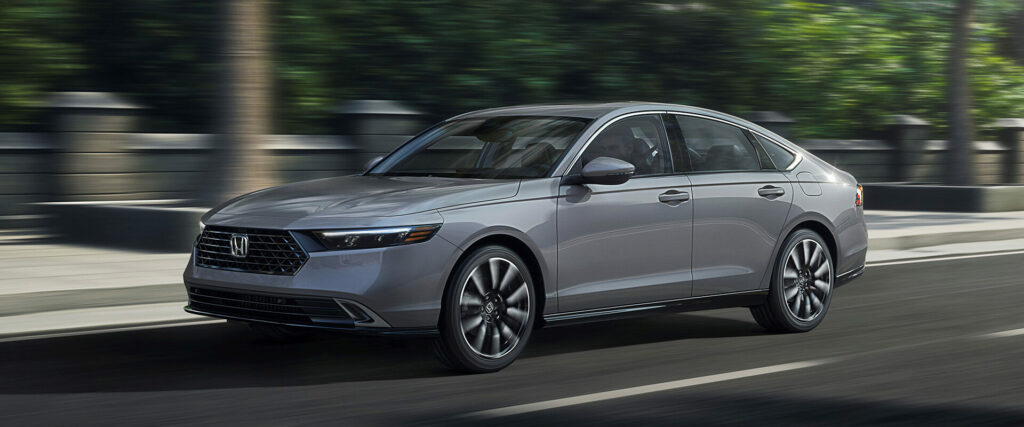
Browse Honda listings in your area
This Fourth of July offers some appealing finance offers for Honda fans. You can snag the powerful Ridgeline at 0.9% APR for 36 months. For those needing a roomy SUV, the Passport is advertised at 2.9% APR for 48 months. Looking to get into an Accord, Accord Hybrid, Civic, CR-V, CR-V Hybrid, HR-V, Odyssey, or a Pilot? These models are all available at a competitive 3.9% APR for 48 months.
Our CarEdge Car Coaches help thousands of buyers find and negotiate the best deals, from trade-ins to purchasing and everything in between. While they’re helping our members, they learn a lot about the state of the auto market.
In recent days, our Coaches have helped our members negotiate incredible deals with brands such as Jeep and Ram. Jeep Grand Cherokees, with great incentives and high inventory, are leading to considerable discounts. Similarly, Ram trucks, especially mid-trim variants of the Ram 1500, are a bargain.
Justise, one of our Car Coaches, says that Ford has some great deals right now. He helps hundreds of car buyers save thousands of dollars every week, so he’s all about the deals. Justise says the Ford Escape and Ford Edge are currently sporting up to 8% discounts in the form of manufacturer rebates, plus extra negotiability with the dealer adding up to over 10% off of MSRP.
The Ford F-150 isn’t lagging behind either, with over 10% being routinely taken off the listing price via rebates and dealer discounts.
Jerry, another one of our fantastic Car Coaches, has identified stellar deals as well. Mazda, with decent availability, is offering discounts of 5% to 8%. Honda Ridgelines are seeing significant cuts of up to $4,000 – $5,000.
Subaru is offering up to 5% discounts and even good leases on the Crosstrek and Forester. If you’re considering VW, you can expect about 7% off on the Volkswagen Atlas.

As the Fourth of July approaches, the CarEdge Team has been working tirelessly to bring you the best car deals in the market. Leveraging our industry insights and car buying tools, we’ve discovered where you could save thousands on a new car purchase this summer.
We’ve combined the best deals curated by our team of professional car buyers with the latest Market Day Supply (MDS) data for every brand in the American auto market to pinpoint the best new car deals this Independence Day.
What exactly is MDS, and why should you care? MDS is a measure of how long the current inventory of a specific car model or brand would last, assuming no additional inventory is added, and sales continue at the current rate. If MDS is high, that generally means there’s an excess of supply over demand, which gives buyers more bargaining power and the potential for bigger discounts.
Don’t expect to see MDS advertised by dealers. Car dealers most certainly would rather you NOT become familiar with how the auto market really works. We’re here to change that. See Market Day Supply and other crucial data points with every new and used car listing in your area at CarEdge Car Search.
Now, on to our findings.
Having choices is always a good thing when you’re shopping for a car. Where there’s a glut of inventory, better deals are sure to follow. Here are the brands with the most inventory right now: Ram (215 MDS), Jeep (170 MDS), Jaguar (149 MDS), Chrysler (146 MDS), and Volvo (143 MDS). Note that Stellantis, who has been struggling with sales, dominates this list. Manufacturer incentives aside, these are the brands that will be most negotiable on dealer lots.
Even better, here’s the latest inventory for every major automaker in America. Note: direct to consumer automakers like Tesla are not included, as they don’t maintain lot inventory.
| Brand | Total Brand MDS | Total New Inventory |
|---|---|---|
| Acura | 66 | 26,201 |
| Alfa Romeo | 127 | 2,814 |
| Audi | 100 | 51,251 |
| BMW | 47 | 32,090 |
| Buick | 112 | 44,964 |
| Cadillac | 46 | 16,203 |
| Chevrolet | 61 | 208,177 |
| Chrysler | 146 | 18,677 |
| Dodge | 85 | 41,620 |
| Ford | 86 | 313,689 |
| GMC | 77 | 89,172 |
| Genesis | 97 | 14,258 |
| Honda | 31 | 97,334 |
| Hyundai | 60 | 108,351 |
| Infiniti | 124 | 18,401 |
| Jaguar | 149 | 2,301 |
| Jeep | 170 | 176,107 |
| Kia | 35 | 62,345 |
| Land Rover | 61 | 7,986 |
| Lexus | 36 | 29,989 |
| Lincoln | 115 | 20152 |
| Mazda | 74 | 64677 |
| Mercedes-Benz | 81 | 59353 |
| Mini | 103 | 8457 |
| Mitsubishi | 76 | 14313 |
| Nissan | 69 | 118133 |
| Porsche | 99 | 13151 |
| Ram | 215 | 111401 |
| Subaru | 43 | 57218 |
| Toyota | 32 | 172851 |
| Volkswagen | 61 | 43565 |
| Volvo | 143 | 36094 |
Honda, Lexus, Kia, Toyota and Subaru are seeing the lowest new car inventory right now, and as a consequence, are less likely to offer attractive deals this July 4th.
On the flip side, Stellantis, GM and Ford have the most inventory. If you’re looking to save thousands off of MSRP, this is your best bet.
Looking for a great deal on something else? Our Car Coaches are always ready to assist you, no matter what car your heart is after. Here’s how we can help.
In the realm of car buying, timing can be everything, and the industry hides a secret that could save you a significant sum. On average, new car incentives are 40% higher during a specific time of the year. Surprisingly, it’s the last week of the year where dealers rush to shift the remaining stock from the previous model year, offering buyers enhanced incentives and negotiation power.
However, the total cost consideration is not as straightforward as it appears. Despite potential year-end savings, rising interest rates, the highest seen in over a decade, can potentially offset your savings, leading to increased monthly payments. Therefore, while end of year sales traditionally offer great deals, current market conditions make this Fourth of July an equally enticing time to consider buying a car.
This is especially true if you’re prepared to negotiate!

Don’t miss these 5 car buying tips for 2023 – they can save you thousands!
In the auto market, the art of negotiation can be the difference between overpaying and a fantastic deal. Particularly in the current market, when inventory is high, and brands are eager to sell, leveraging your negotiation skills could result in thousands of dollars in savings. Keep in mind that high MDS numbers mean more wiggle room for negotiations. So, whether you’re eyeing a Jeep Grand Cherokee or considering a Ford F-150, remember, a well-negotiated deal can lead to considerable savings this Fourth of July.
Ready to master the art of negotiating your next car purchase to save thousands of dollars? You came to the right place! Our team of CarEdge Car Coaches helps hundreds of car buyers just like you become empowered consumers ready to take control of your deal. When you enter the dealership equipped with CarEdge Data and the wisdom and skills shared by your CarEdge Coach, you’ll be ready to conquer car buying once and for all.
Regardless, we hope to see you at the CarEdge Community Forum, where tens of thousands of like-minded drivers share the best deals and car buying tips in the internet’s most inclusive, welcoming automotive community. We’re here to help!
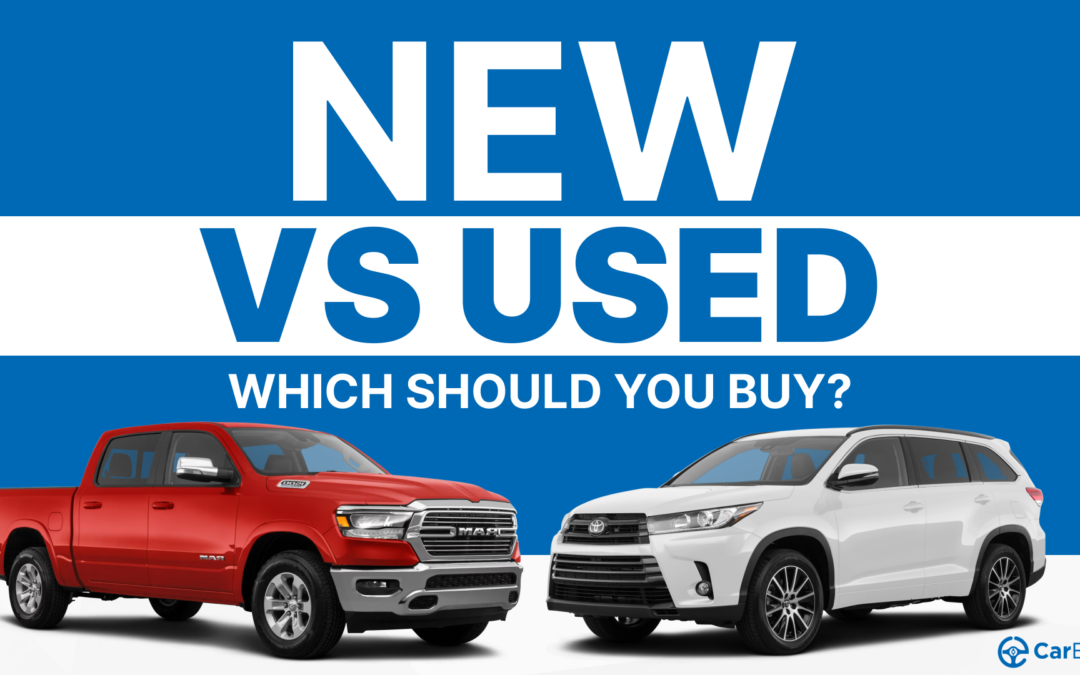
Used car price trends in 2023 have been difficult to keep track of. One week prices are going up, the next week prices are falling down.
Don’t worry, CarEdge has got your back.
Whether you are in the market to buy a used car, or are thinking about selling a car you already own, we’ve crunched the numbers so that you can clearly understand what trends are happening in the used car market right now.
Buckle up, let’s explore these essential insights together.
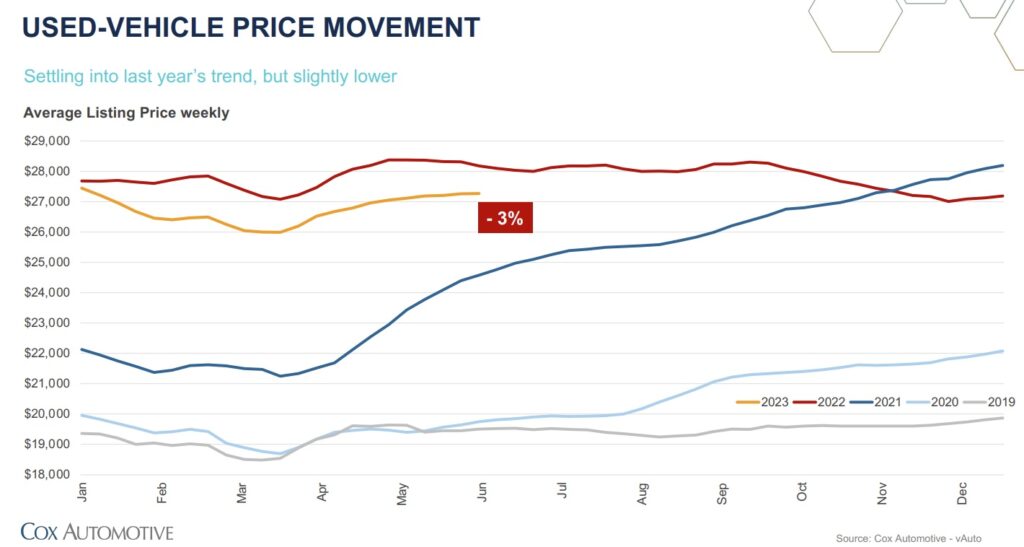
A new analysis from Cox Automotive shows that used car sales are slowing, and at the same time available used vehicle inventory is diminishing.
The multi-year chip shortage that reduced global production of new vehicles in 2021 and 2022 means there are fewer 1 and 2 year old used cars in the market today. This lack of supply is keeping used car prices elevated even as the average interest rate on a used car reaches 13.5%.
Nationwide, used car supply stands at approximately 2.2 million units, a decrease of 256,000 compared to June of the prior year. Quality used cars are still fetching a premium at dealer auctions, however they are fewer and further between.
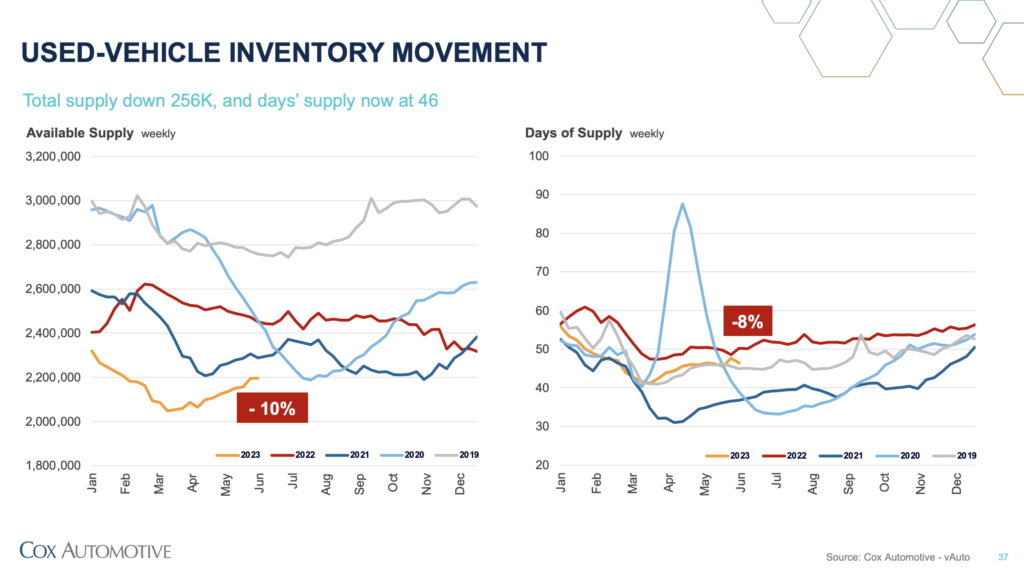
What goes up, must come down. But when it comes to the used car market of the past 24 months that hasn’t been the case. Where do things stand in mid-2023? “I think the used car market is in flux,” notes Ray, “we are seeing a steady decline in wholesale values at the auctions that is barely reflected on the retail side.” He further explains that quality late-model used cars remain in short supply and still command high prices, stating that “those retail prices won’t be dropping much, if at all, in the near term.”
Used car price trends in 2023 look very different across the various segments of vehicles that are sold in the United States. Over the past 24 months we saw major increases in price for “cheaper” used vehicles ($10,000 or less), as consumers looked for any car that could reliably get them from point a to point b without breaking their bank.
Interestingly today, the largest dips in wholesale used car prices are being seen in lower-quality cars and “cheaper” vehicles. This could signal some relief for consumers who are looking for something reasonably priced. “The lower quality cars at the auctions are what are seeing the real declines in values, so whatever retail future price drops that there are will probably be reflected mostly in this group of vehicles,” Ray explained.
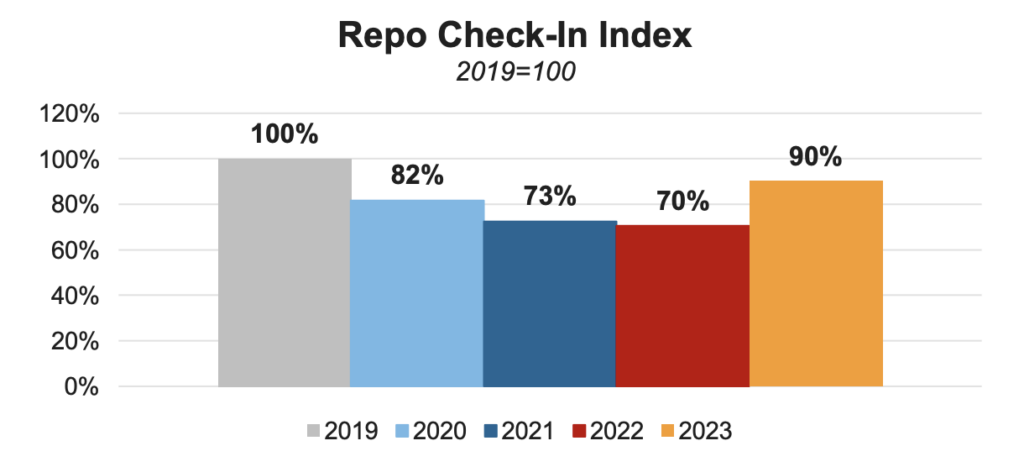
This trend coincides with auto repos increasing significantly. During the pandemic very few vehicles were repossessed. Now, as auto loan delinquency rates increase, we are seeing the number of repo vehicles showing up at dealer auctions increase as well. Typically repossessed vehicles have been treated a bit more “roughly” than other sources of used vehicle inventory (lease returns for example).
Financial institutions are tightening their lending guidelines in response to higher loan delinquency rates. This shift will significantly influence overall sales as it will be more difficult for consumers to find deals within their monthly budget or get approved for financing.However, those with the capacity to purchase the more expensive, higher-quality used cars are likely to continue doing so due to their financial capability to weather these lending challenges. “Those who can and do buy the overpriced newer used cars can and will continue to do so because A) they can put more money down to qualify for a loan and B) they have the ability to be able to afford the higher payment.”
On the flip side, those aspiring to purchase older, cheaper cars may encounter obstacles in qualifying for loans under these stringent guidelines, potentially precipitating a steeper price decline in this vehicle category. Looking forward, high retail prices for low-mileage vehicles a few years old are expected to persist due to ongoing customer demand and limited availability. “I believe that high retail prices will continue well into the future for the 1,2 and 3-year-old lower mileage vehicles because of continued high customer demand and limited availability. I believe that we will still be complaining about high retail prices for quite some time.”
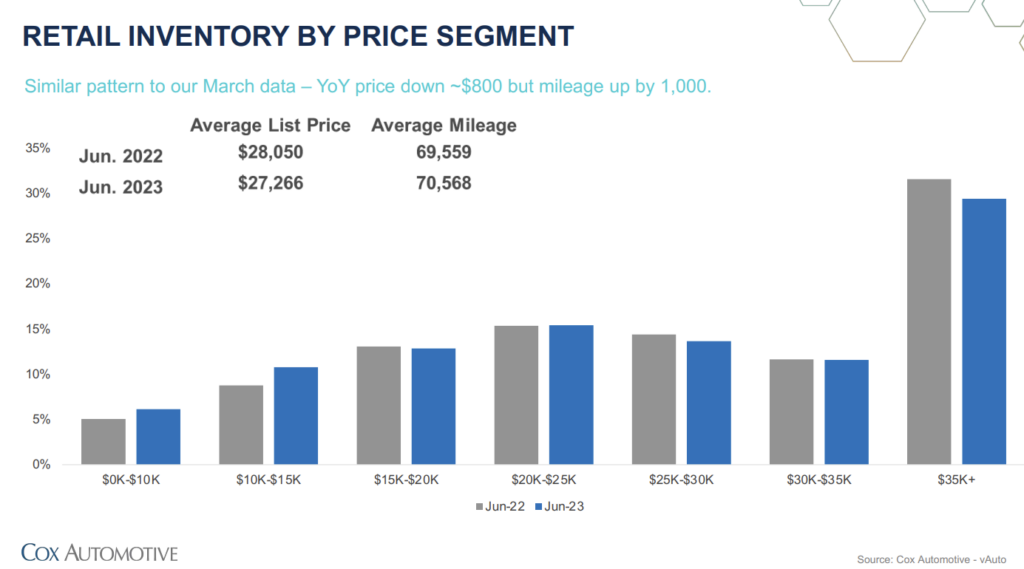
Although the average listing price for used cars in America has dipped 3% since this time last year, they are still near all-time highs. To give some perspective, the average used car price is 39% higher than in 2019 and into pre-pandemic 2020. This dip may represent a relative ‘cooling off,’ but used car prices remain far from pre-pandemic norms.
While retail prices for used cars have dipped slightly since the beginning of 2023, wholesale prices have stabilized, returning to where the year began. This shift might hint towards an equilibrium in the market after a period of intense fluctuations.
An interesting trend is the rising mileage of used car inventory. This change signifies that more drivers are holding onto their cars for longer, a response to continually increasing new car prices that outpace overall inflation. As the cost of buying new becomes less attainable, owners are maximizing the value of their existing vehicles.
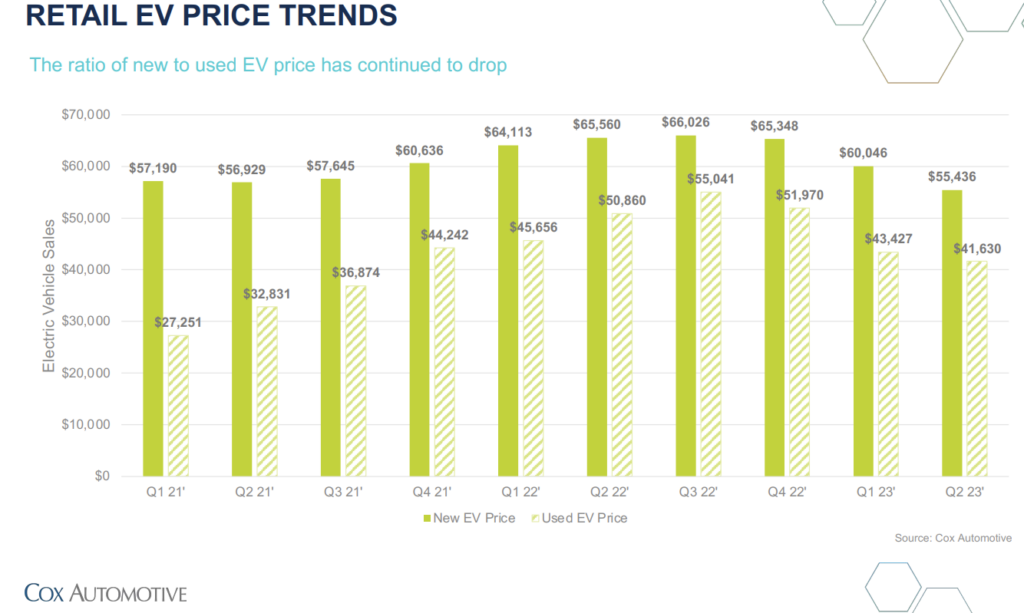
In the world of EVs, things are always changing. Over the past year, the gap between new and used EV prices has narrowed significantly. The rise in new EV inventory, up by a staggering 342% year-over-year, coupled with multiple price adjustments from Tesla, has led to a major correction in the used EV market.
In Q2 of 2023, the average price of a used EV stands at $41,630, quite a bit lower than the $50,000 average a year ago. However, considering the unavailability of federal incentives for used EVs over $25,000 and the abundance of local, state and federal incentives for new EVs, many buyers may still find buying a new EV to be their best bet. For a complete list of eligible cars, check out fueleconomy.gov.
Even though used car prices are experiencing a slight drop, it’s not enough to counteract the significant increases we’ve seen over the last few years. However, with new car inventory increasing rapidly, we’re witnessing the return of buyer incentives, leading to potentially better deals. Moreover, buying new often comes with the added benefit of a full manufacturer warranty.
Stay tuned to CarEdge for the latest insights on car buying trends as we continue to monitor these evolving market conditions. Whether you’re considering a used or new vehicle, we’re here to help you make the most informed decision. Looking for behind-the-scenes market data for new and used vehicles? CarEdge Data is the perfect plan. Ready to dig deep with your top picks? Run a CarEdge Report for the most insights you’ll find anywhere.
Our Coaches are always ready to guide you through your deal with our CarEdge Coach plan.
We’re here to help!